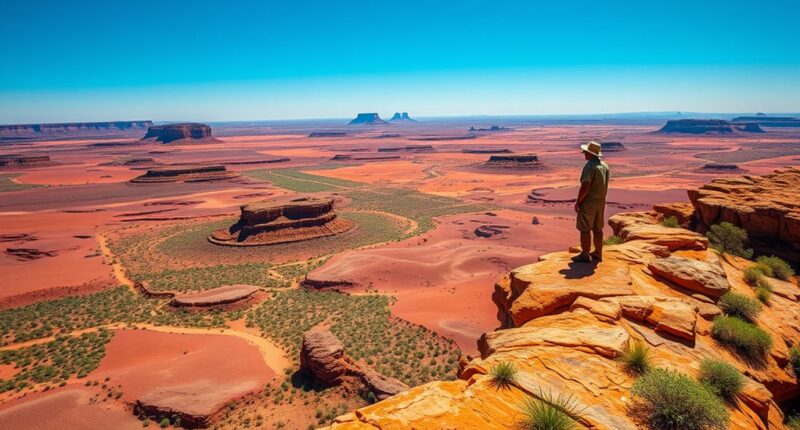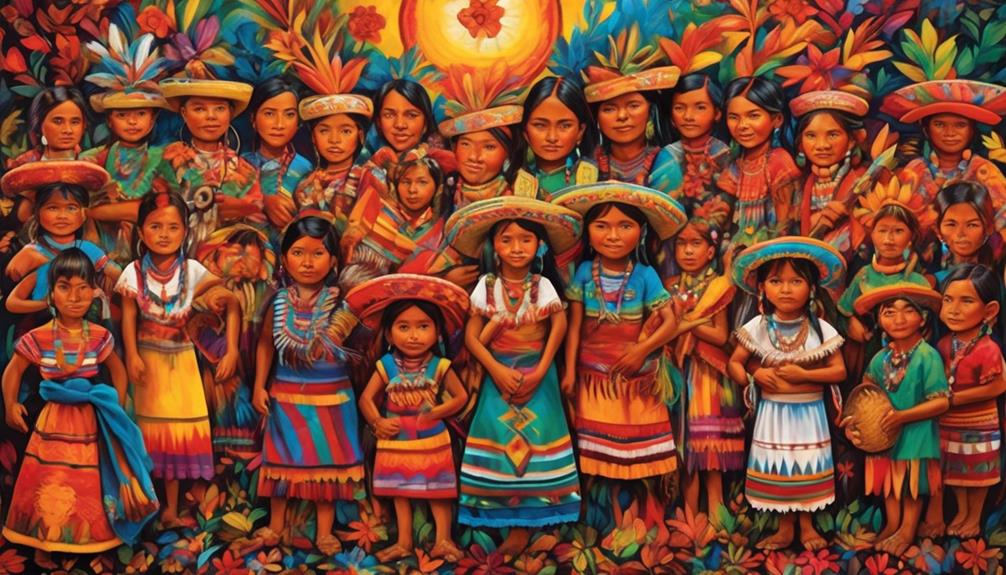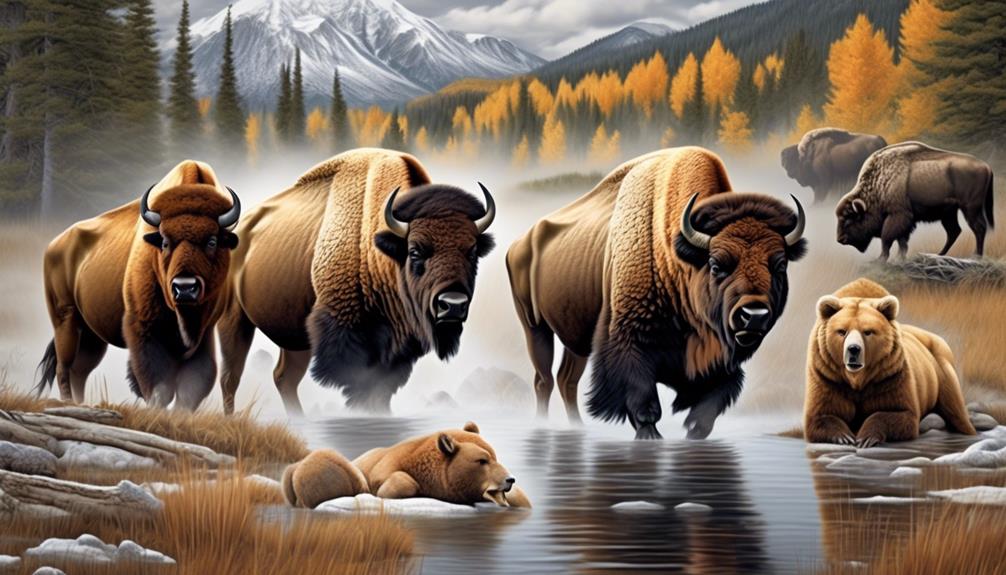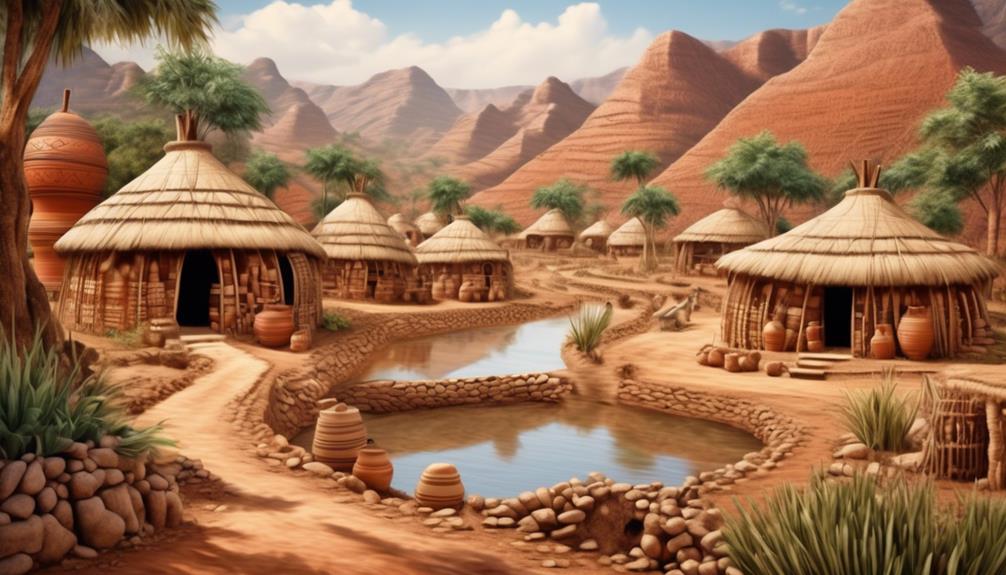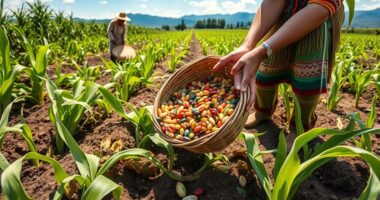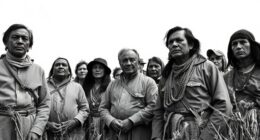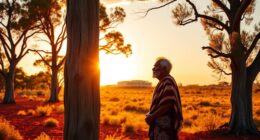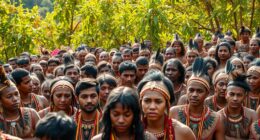Indigenous rangers help protect nearly half of Australia’s land by combining traditional knowledge with modern conservation methods. They manage vast areas, conduct controlled burns, and safeguard cultural sites while promoting biodiversity and ecosystem health. Working with communities, scientists, and government agencies, they make certain land stays healthy and culturally significant. Their holistic approach preserves both nature and cultural heritage, showing how blending old and new ways keeps Australia’s landscapes thriving. Keep exploring to see how their efforts shape the future.
Key Takeaways
- Indigenous Rangers combine traditional knowledge with modern conservation techniques to manage nearly half of Australia’s landmass.
- They conduct controlled burns rooted in cultural practices to prevent large wildfires and promote ecosystem health.
- Rangers protect sacred sites and cultural landscapes, ensuring cultural preservation alongside environmental conservation.
- They collaborate with communities, scientists, and government agencies to enhance land management strategies.
- Indigenous Rangers serve as cultural ambassadors, fostering respect for Indigenous ways of life while safeguarding land and ecosystems.
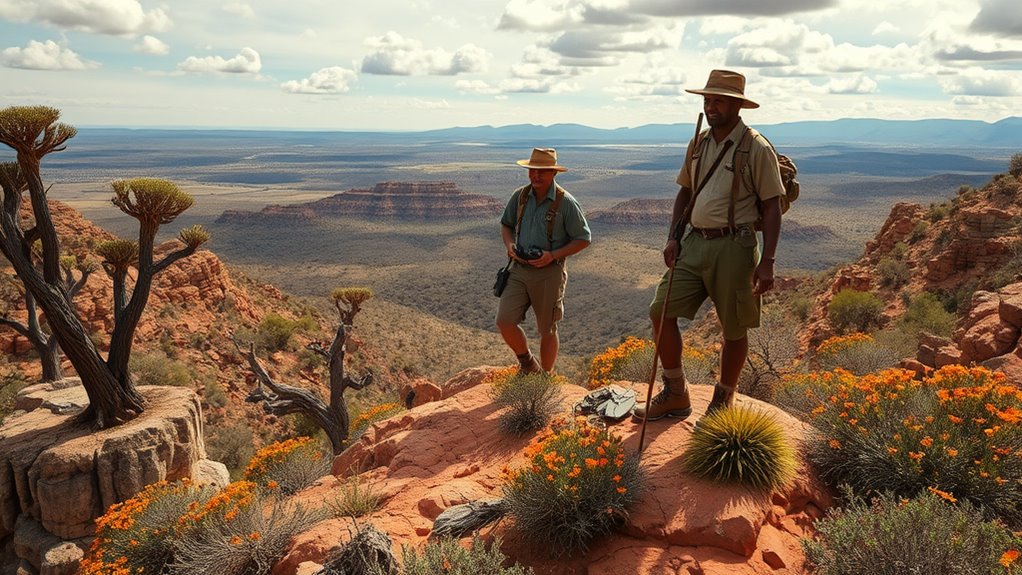
Across Australia, Indigenous rangers are playing an essential role in safeguarding the country’s land and ecosystems. You might not realize it, but these rangers are vital stewards of vast areas—covering approximately 44% of the landmass—where they combine traditional knowledge with modern conservation techniques. Their work goes beyond protecting the environment; it’s about cultural preservation intertwined with land management. As you learn about their efforts, you’ll see how deeply connected Indigenous communities are to their land, viewing it not just as a resource but as a cultural landscape that holds stories, traditions, and identities.
Indigenous rangers safeguard 44% of Australia’s land, blending traditional knowledge with modern conservation.
Indigenous rangers actively manage ecosystems by implementing fire management practices rooted in thousands of years of tradition. These controlled burns help prevent larger wildfires, promote biodiversity, and maintain the health of landscapes. You might think land management is solely about conservation, but for these rangers, it’s also about restoring and maintaining cultural sites. They protect sacred sites, ensuring that cultural heritage remains intact while fostering ecological resilience. This dual approach guarantees that land isn’t just preserved physically but also culturally, keeping Indigenous stories alive through the land itself.
Their work is collaborative, often involving local communities, scientists, and government agencies. You can appreciate how this partnership enhances land management strategies, blending scientific research with Indigenous expertise. As they monitor wildlife, control invasive species, and rehabilitate degraded areas, they’re also passing down traditional ecological knowledge. This knowledge isn’t just relic; it’s a living system that guides sustainable practices, ensuring the land remains healthy for future generations. When you see Indigenous rangers in action, you recognize that their efforts are about more than conservation—they’re about cultural continuity and sovereignty.
The rangers’ efforts extend into educating others about Indigenous perspectives on land. They serve as ambassadors, sharing stories that highlight the importance of respecting and understanding Indigenous ways of life. Through their work, they demonstrate that protecting land isn’t just an environmental concern; it’s a cultural imperative. You might find yourself inspired by their dedication, understanding that true land management incorporates respect for cultural heritage alongside ecological health.
In essence, Indigenous rangers are guardians of Australia’s land and culture. They are proving that effective conservation requires honoring traditional knowledge and practices. As you follow their work, you’ll see how their efforts help secure a sustainable future—where land management and cultural preservation go hand in hand, ensuring that Australia’s natural and cultural landscapes thrive for generations to come. Moreover, their integration of modern conservation techniques with Indigenous practices highlights the importance of a holistic approach to environmental stewardship.
Frequently Asked Questions
How Are Indigenous Rangers Funded Long-Term?
You might wonder how Indigenous rangers secure long-term funding. They often rely on diverse funding strategies, including government grants, partnerships with conservation organizations, and community engagement initiatives. These approaches help guarantee stable financial support, enabling rangers to continue their essential work. By fostering strong community ties and demonstrating their impact, Indigenous rangers can attract ongoing funding, which sustains their efforts to protect land and culture over the long term.
What Training Do Indigenous Rangers Receive?
You’ll find that Indigenous rangers receive extensive training that combines traditional knowledge with modern conservation techniques. This includes learning about cultural practices, land management, and biodiversity protection, often led by elders and community experts. The training emphasizes respecting cultural heritage while applying practical skills for environmental preservation. By blending traditional knowledge with contemporary methods, rangers are empowered to protect and manage Australia’s land effectively, ensuring cultural and ecological sustainability.
How Do Rangers Collaborate With Government Agencies?
Think of Indigenous rangers as bridges connecting worlds. You’ll see them collaborate with government agencies through ongoing community engagement, sharing traditional knowledge and respecting cultural preservation. They work hand-in-hand on conservation projects, coordinate patrols, and develop policies that honor both Indigenous ways and scientific methods. This partnership guarantees land management respects cultural significance while protecting ecosystems, creating a harmonious effort that benefits everyone involved and keeps Australia’s land healthy for generations.
What Challenges Do Indigenous Rangers Face Daily?
You face daily challenges like balancing cultural preservation with community engagement, often working in remote areas with limited resources. You endeavor to protect sacred sites and traditional knowledge while fostering trust within your community. Environmental threats and bureaucratic hurdles can make your work difficult, but your dedication ensures the land’s health and cultural legacy remain strong. Your resilience helps sustain both your community and Australia’s natural landscapes.
How Is the Success of Their Conservation Efforts Measured?
You measure the success of Indigenous Rangers’ conservation efforts through cultural preservation and community engagement. Their work isn’t just about protecting land but also about maintaining traditions and involving local communities in stewardship. Indicators include healthier ecosystems, increased native species, and stronger cultural practices. When communities actively participate and traditions thrive, you can see their efforts making a real, lasting impact on Australia’s land and cultural heritage.
Conclusion
As you see, it’s no coincidence that Indigenous rangers, deeply connected to the land, are safeguarding nearly half of Australia’s vast landscape. Their dedication proves that tradition and modern conservation can work hand in hand, often in surprising ways. When you realize how their ancient knowledge aligns so perfectly with today’s environmental needs, it becomes clear that protecting the land isn’t just a duty—it’s a deeply rooted coincidence shaping Australia’s future.
